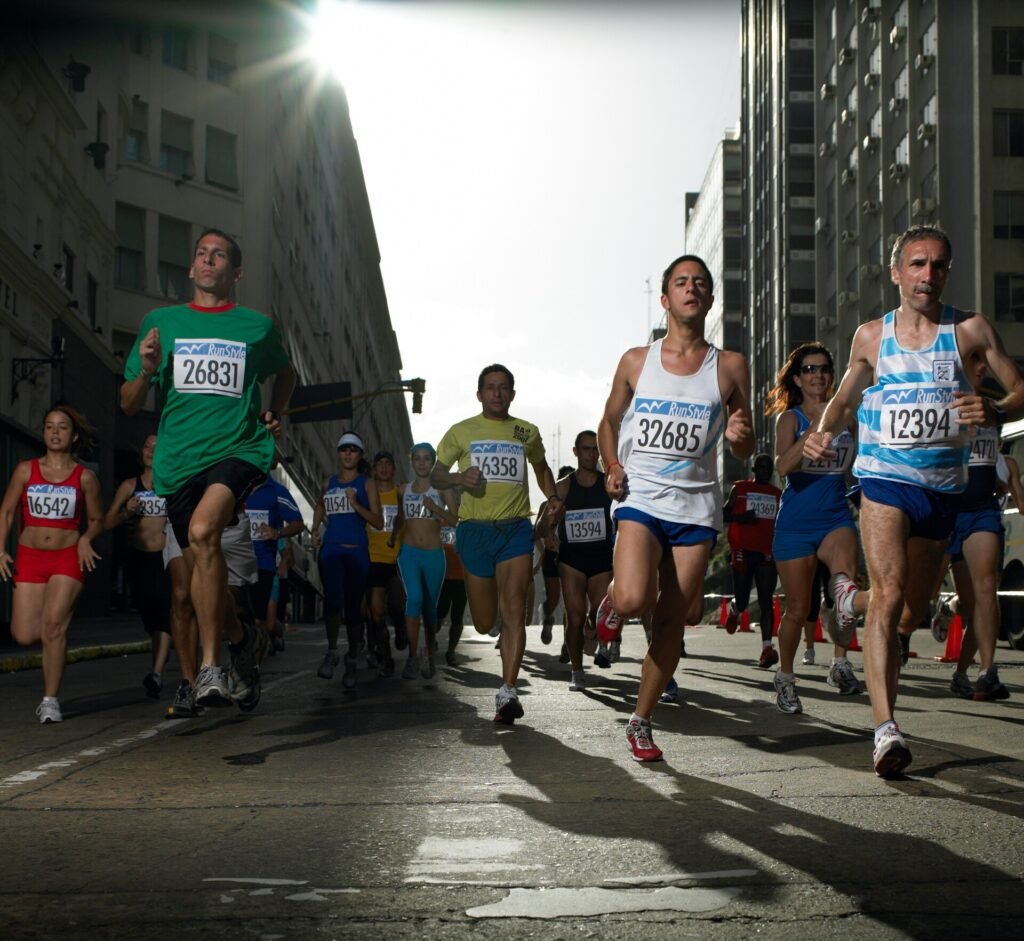Running is something we all do, whether it’s chasing a bus or going for a morning jog. It’s a natural, instinctive activity that’s been part of human life for as long as we can remember. But have you ever wondered when running first started?
Running has played a crucial role in human history. Our ancestors used it to hunt for food, escape from danger, and travel long distances. It was essential for survival, shaping how early humans lived and evolved. Over time, running moved from being a survival skill to becoming a part of our culture, from ancient races to modern marathons.
So, next time you go for a run, remember you’re not just getting exercise—you’re connecting with a long tradition that’s been around for thousands of years. Let’s explore the origins of running and see how this simple act has shaped human history.
What Year Was Running Invented? A Look at Its Origins and Key Developments
However, if you’re referring to organized or competitive running, key historical milestones include:
- 776 BCE: The first recorded running event took place during the ancient Olympic Games in Greece.
- 1896: The modern Olympic Games included running events, marking a significant development in organized competitive running.
- 1970s: The popularization of marathons and running clubs in the United States helped solidify running as both a competitive sport and a popular recreational activity.
Running, as a natural and instinctive activity, doesn’t have a precise moment of invention—it’s been around for as long as humans have existed. To understand its origins, we need to look back to our earliest ancestors.
Long before organized sports or structured workouts, running was a fundamental part of survival. Early humans relied on their ability to run for hunting, gathering, and escaping predators. Archaeological evidence suggests that our ancestors were running long distances as early as 2 million years ago. Fossils and ancient footprints indicate that running was a key part of their daily lives.
The concept of running as we know it began to take shape with the advent of civilization. Ancient cultures like the Greeks and Romans recognized running as a vital skill and celebrated it through events like the Olympic Games, which started around 776 BCE. These early competitions laid the groundwork for modern running sports.
Significance Of Running In Ancient Cultures
| Ancient Civilization | Significance of Running | Religious and Ceremonial Practices |
| Ancient Egypt | Essential for military training and athletic events | Used to build endurance and strength; part of military and royal practices |
| Mesopotamia | Popular form of entertainment and competition | Running competitions honored gods and showcased personal valor |
| Native American Tribes | Spiritual and physical activity | Long-distance runs were part of rituals and ceremonies, symbolizing endurance and spiritual connection |
Who Invented Running? Exploring the Roots of a Natural Human Activity
Running, in the sense of the basic human activity of moving quickly on foot, wasn’t “invented” by any one person or at a specific point in time. Instead, it evolved naturally as a fundamental aspect of human physiology and survival. Here’s a brief overview of how running came to be recognized and celebrated through history:
- Primal Origins: Early humans and their ancestors engaged in running as a basic survival skill. This involved chasing prey, escaping predators, and covering distances for migration or gathering food. This form of running predates recorded history and was essential for early human life.
- Ancient Cultures:Ancient Greece: Running began to be formalized and celebrated with the creation of the Olympic Games around 776 BCE. These early competitions were some of the first instances of organized running as a sport. Ancient Egypt and Mesopotamia: Running was part of military training and ceremonial practices, reflecting its importance beyond mere survival.
- Modern Era: The development of organized running as a sport continued through the ages. The 19th and 20th centuries saw the establishment of standardized rules and international competitions, including the modern Olympics and various marathon events.
Running as a Sport in Ancient Times

In ancient Greece, running was elevated from a basic human activity to a celebrated sport, thanks to the establishment of the Olympic Games. Held every four years starting in 776 BCE, these games were a major event in Greek culture, showcasing athletic prowess and honoring the gods.
“Running is the greatest metaphor for life because you get out of it what you put into it.” — Oprah Winfrey
1. Running Events in the Ancient Olympic Games
The ancient Olympics featured several running events, each with its unique twist:
- Stadion Race: The simplest and most prestigious race, covering a distance of roughly 192 meters (about 210 yards), equivalent to the length of the stadium.
- Diaulos: A race that involved running twice the length of the stadium, approximately 384 meters (about 420 yards).
- Dolichos: A long-distance race that varied in length but could be as long as 4,800 meters (about 3 miles), testing endurance as well as speed.
2. Types of Races and Their Cultural Significance
Running events in the ancient Olympic Games held significant cultural importance:
- Religious Symbolism: Races were dedicated to the gods, particularly Zeus, and were seen as both a physical and spiritual endeavor. Victories were believed to bring favor from the deities.
- Honor and Prestige: Winning a race was a mark of great honor and prestige, not just for the athlete but also for their city-state. Victors were celebrated with statues, poems, and lifelong privileges.
- Physical Excellence: The emphasis on running highlighted the Greeks’ admiration for physical fitness and athletic skill, reflecting broader values of health, discipline, and competition.
Running as a Competitive Sport in Ancient Rome, Mesoamerican Cultures, and Other Civilizations
| Civilization | Competitive Running | Significance and Context |
| Ancient Rome | – Races held in circuses (e.g., Circus Maximus)- Various race types including sprints and endurance events | – Part of public games (ludi)- Entertainment and religious festivals- Combined with other events like gladiator contests |
| Mesoamerican Cultures | – Long-distance races- Ball games like ullamaliztli involving running | – Tied to religious and ceremonial practices- Symbolic significance in rites- Ritualistic and competitive aspects |
| Ancient China | – Running as part of military training- Competitive events mentioned in Shujing | – Important for military readiness- Part of athletic competitions |
| Ancient Persia | – Running events as part of athletic festivals- Training for military purposes | – Valued for physical fitness- Included in larger athletic and military training events |
The Popularity of Running Across the World
Running has evolved from an ancient practice into a globally celebrated sport, enjoyed by millions of people of all ages and abilities. Its universal appeal and accessibility have led to a significant rise in amateur and recreational running, as well as the establishment of major global events.
Increase in Amateur and Recreational Running
- Widespread Participation: Running has become a popular activity for people looking to improve their health, relieve stress, and enjoy outdoor exercise. From casual joggers to dedicated fitness enthusiasts, running is accessible to individuals at various fitness levels.
- Local Running Groups and Clubs: Many communities have established running groups and clubs that provide support, motivation, and a sense of camaraderie for runners of all abilities. These groups often organize local events, training sessions, and social runs.
- Health and Fitness Trends: The growing awareness of the health benefits of running, including cardiovascular fitness, mental well-being, and weight management, has contributed to its widespread popularity. Running is often promoted as an easy and cost-effective way to stay fit.
The Rise of Global Events
| Type of Event | Description | Examples | Key Features |
| Marathons | Long-distance races covering 26.2 miles (42.195 kilometers), attracting participants from around the world. | – Boston Marathon- London Marathon- New York City Marathon | – Competitive and celebratory- Major global participation- Personal achievements and community spirit |
| Ultra-Marathons | Races exceeding the traditional marathon distance, often challenging extreme endurance athletes. | – Western States Endurance Run- Marathon des Sables | – Distances over 26.2 miles- Demanding terrains and conditions- Extreme physical and mental challenge |
| City Runs and Fun Runs | Shorter, inclusive running events designed to be festive and accessible to all participants | – Local 5Ks- 10Ks- Color Runs | – Emphasis on fun and community- Ranges from 5K to 10K- Inclusive and family-friendly |
Benefits of Running for Physical and Mental Health
“Running is about finding your inner peace, and so is a life well lived.” — Dean Karnazes, ultramarathon runner
1. Physical Health Benefits
- Cardiovascular Fitness: Running strengthens the heart and improves circulation, which helps to reduce the risk of heart disease and stroke. Regular running increases cardiovascular endurance and efficiency.
- Weight Management: As a high-calorie-burning activity, running aids in weight control by boosting metabolism and promoting fat loss. It helps to maintain a healthy body weight and prevents obesity.
- Bone Density: Weight-bearing exercise like running enhances bone strength and density, reducing the risk of osteoporosis and fractures. It stimulates bone-building processes and supports overall skeletal health.
- Muscle Strength: Running engages multiple muscle groups, including the legs, core, and arms. It helps to build and tone muscles, improve muscular endurance, and increase overall strength.
2. Mental Health Benefits
- Stress Relief: Running is known for its ability to reduce stress and anxiety. The release of endorphins, often referred to as “runner’s high,” creates a sense of well-being and relaxation.
- Improved Mood: Regular running can alleviate symptoms of depression and enhance mood. Physical activity stimulates the production of neurotransmitters like serotonin and dopamine, which are linked to improved emotional health.
- Cognitive Function: Running supports brain health by improving cognitive functions such as memory, focus, and learning. It has been shown to promote neurogenesis (the growth of new brain cells) and improve overall mental clarity.
Influence of Famous Runners and Events on Popularizing the Sport

1. Impact of Iconic Runners
a. Steve Prefontaine
- Achievements: Steve Prefontaine was an American long-distance runner who set numerous records in the 1970s and was known for his aggressive racing style and charismatic personality.
- Impact: Prefontaine’s success and his passionate advocacy for athletes’ rights brought significant attention to distance running in the United States. His legacy continues to inspire runners and contribute to the sport’s popularity.
b. Eliud Kipchoge
- Achievements: Eliud Kipchoge is a Kenyan marathon runner widely regarded as one of the greatest distance runners of all time. He won multiple Olympic gold medals and famously broke the two-hour barrier in the marathon duringF the INEOS 1:59 Challenge.
- Impact: Kipchoge’s incredible achievements and his dedication to the sport have elevated the profile of marathon running globally. His quest for excellence and his motivational story have inspired countless individuals to take up running.
c. Usain Bolt
- Achievements: Usain Bolt, known as the fastest man in the world, set world records in the 100-meter, 200-meter, and 4×100-meter relay. His performances in the Olympics and World Championships captivated audiences worldwide.
- Impact: Bolt’s charisma, speed, and showmanship brought global attention to sprinting. His dominance on the track and engaging personality have made sprinting one of the most popular and exciting disciplines in athletics.
2. Influence of Major Running Events
a. The Boston Marathon
- History: Established in 1897, the Boston Marathon is one of the oldest and most prestigious marathons in the world.
- Impact: The Boston Marathon has a rich history and tradition that attracts top runners and thousands of participants each year. Its challenging course and the significance of qualifying standards have made it a coveted race, contributing to the sport’s prestige and popularity.
b. The Olympics
- History: The modern Olympic Games, revived in 1896, have featured athletics as a core component since their inception.
- Impact: The Olympics showcase a wide range of running events, including sprints, middle-distance, long-distance, and marathon races. The global platform of the Olympics brings significant attention to running, highlighting the sport’s best athletes and creating a sense of global competition and camaraderie.
c. The New York City Marathon
- History: First held in 1970, the New York City Marathon is one of the largest and most famous marathons in the world.
- Impact: The event attracts elite runners and amateur participants from around the globe, and its route through all five boroughs of New York City creates a unique and inclusive atmosphere. The marathon has helped popularize running in the United States and worldwide, inspiring people to participate.
d. The Berlin Marathon
- History: The Berlin Marathon, established in 1974, is known for its fast, flat course and has been the site of numerous world record performances.
- Impact: The event’s reputation for fast times has drawn top runners worldwide and contributed to Berlin’s status as a major hub in the international marathon circuit. It has played a key role in the global marathon scene.
e. The Tokyo Marathon
- History: As part of the World Marathon Majors, the Tokyo Marathon has grown in prominence since its inception in 2007.
- Impact: The Tokyo Marathon’s inclusion in the World Marathon Majors series and its position in a major global city have helped raise the profile of marathon running in Asia and attract a diverse international field.
3. Legacy and Outreach
a. Charitable Runs and Community Events
- Examples: Events like the Color Run and various charity runs have made running accessible and enjoyable for people of all ages and fitness levels.
- Impact: These events often focus on fun, community engagement, and fundraising, broadening the appeal of running beyond competitive circles and encouraging widespread participation.
b. Media and Coverage
- Examples: Increased media coverage of running events and athletes through television, online streaming, and social media has helped elevate the sport’s visibility.
- Impact: Enhanced media exposure allows fans to follow major events and athletes closely, contributing to greater interest and participation in running.
Closing Thoughts
Let’s take a moment to reflect on how running has evolved from its early days. It all started with ancient cultures using running for practical needs and ceremonies. Fast forward to today, and running has grown into something far bigger. From those first organized races in Ancient Greece to the massive marathons and global events we see now, running has truly become its own.
Think about it: what makes running so special? It’s its simplicity and the fact that almost anyone can do it, anywhere. Whether you’re racing in a world-renowned marathon or just jogging around your neighborhood, running uniquely connects people. It’s incredible how this activity has become a universal sport that brings us all together, no matter where we’re from or what our background is.
Looking ahead, it’s exciting to think about how technology and new trends will continue to shape running. We’ll see even more innovations that make it easier and more enjoyable. And as we lace up our running shoes and hit the pavement, we can appreciate both its rich history and its bright future. Running isn’t just a sport; it’s a way of life that keeps us connected and moving forward.
Running can bring great benefits to our body and mind. It can not only enhance our physical fitness but also relieve our stress, relax our nerves, and reduce anxiety. We can reward ourselves with Custom Running Medals after completing the running plan to motivate ourselves to keep running, constantly improve our endurance and speed, and get our own honor.










